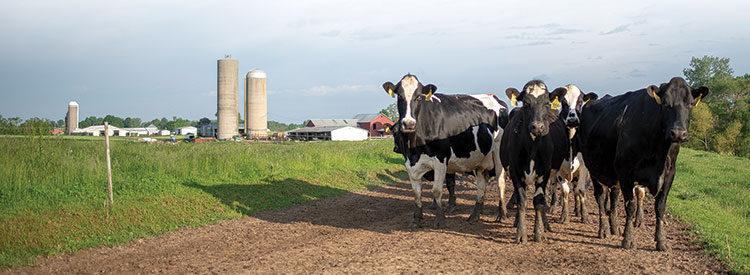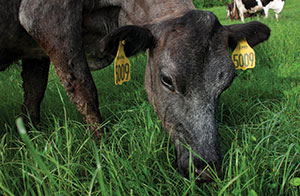
Every farm or ranch has a list of traditions or specific ways of doing things. For most family farms, that list is long. As the farm is passed on to a new generation, the traditions move forward as well. But with each advancing year, some things get left behind or changed to fit new technology or to compensate for hard times.
Changes are often subtle, but sometimes they become a new way of life on the farm. The latter was the case for Bob and Debbie Eash. Their family is currently the fifth and sixth generations at the helm of Country Meadows Dairy in Hudson, Ind., with sons Bryan and Kevin and daughters Lauren and Katelyn, also involved in the operation. The farm was a traditionally run Holstein operation for over 100 years, but when the newly married couple was put in a tight economic situation, all of that began to change.
Forced to change
The Eashes started their own consignment herd of Jerseys after they finished college, but only a few months into their endeavor, they found stray voltage in their parlor. With no other options, they moved their small herd of cows a few miles down the road to the home farm owned by Debbie’s parents.
The addition of the Jerseys made the herd two times the size their facilities could handle. Because there was so little space, they started grazing their lower production cows and, with time, the transition to be an all-grazing farm began.
“We liked how those cows were performing, so we began thinking about moving all the cows to grazing,” Bryan, the eldest son in the Eash family, said. “We were grazing because we had to, but it turned out to be one of the best decisions we ever made,” added the 2019 winner of the American Forage and Grassland Council’s Forage Spokesperson Contest.
Now, 23 years later, the farm is a fully grazing operation with 200 acres of pasture at the home farm where the milk cows graze and 240 additional acres are down the road for heifers and dry cows.
Embracing a mixed herd
The farm is currently milking 230 cows with the herd being a mixture of Jerseys, Holsteins, Milking Shorthorns, and even some New Zealand breeds. When I arrived, the cows were slowly starting to trudge down the dirt path to the pasture after their morning milking. Watching them walk down the hill, it was easy to distinguish the menagerie of breeds, forming a colorful quilt-like pattern against the green landscape.
When the families combined the two herds, the biggest issue faced other than the lack of space was the size difference. “We were trying to feed two different-sized herds,” Bryan noted. Instead of selling off the different breeds, they began breeding to even out the size of their cows.
All the cows are artificially inseminated (A.I.) for the first two breeding cycles, then a bull is used to breed any that are still not pregnant. Bryan, Bob, and Kevin do all of the A.I. breeding. “Usually it’s a competition to see who has the best conception rate,” Bryan joked. “But honestly, we have all gotten pretty good at it.”
The farm utilizes a biseasonal calving system. A majority of their cows calve in the spring with 150 to 180 calves arriving as pastures begin growing. These cows will dry up in the fall and will stay on a sod pasture with wind protection over the cold winter months.
The year-round milk check was a big reason they chose biseasonal calving over single season calving. “There was also some resistance to get rid of good cows just because they weren’t fitting the calving season,” Bryan explained. “If they don’t fit the two cycles, then they can go be a good cow for someone else.”

Understand their pastures
Eash explained that they work constantly to find and understand the trends between their pastures and the cows’ milk production, using monthly milk tests and daily milk weight records to help guide decisions.
Their pastures have a variety of grasses and legumes, including ryegrass, meadow fescue, white clover, and forage chicory. They will plant corn for silage and after it’s chopped, they plant cover crops to protect the soil. These cover crops include triticale, ryegrass, winter peas, and radishes. At the end of the season, the cover crops are either harvested or used for grazing.
The Eashes strive to use all their corn silage during the winter and graze on grasses over the summer. When feeding corn silage, they use soybean grain to balance out the lower quality forage. In the summer, they balance any nutritional issues using a little grain, but they try to rely mostly on high-quality grasses.
The family takes advantage of their pastures and work to get the most from each grazing period. They avoid overgrazing to control excessive legume growth and will apply nitrogen fertilizer when necessary. In the spring, they keep the pasture areas small and move cows to leave about 4 inches of residual growth.
When a pasture isn’t producing to potential, it’s reseeded. Bryan explained, “Typically, pastures are turned over and reseeded every six years, but we often use a plate meter to judge whether reseeding is actually necessary.”
It’s a well thought-out system and the Eashes have a clear understanding of what works for them. Even with the less than ideal conditions this spring, their pastures were thick and green.
Rain isn’t always so abundant as it was this spring and the Eash farm is located on sandy soils, which are not known for their water-holding capacity.
During a year with especially dry conditions, the Eashes used a small irrigation system to spur growth in a section of their pasture. “It was crazy. The only green spot in the entire pasture was what was irrigated,” Bryan explained.
After that year, they began to expand their system and now a pivot irrigator covers 150 acres on the home farm. They also use a towable pivot for other pastures.
Dairy farmers and businessmen
When Bryan began college, he had every intention of leaving behind the dairy industry. “I always told myself there was no way I was going back to dairy farming,” he joked. But while studying to get his two degrees in business at Purdue University Fort Wayne, he began to see the connection between business and the dairy farm. “Assets are what produce money and biological assets reproduce themselves. It just made sense,” Bryan explained.
After college, he worked for a large grazing dairy in Georgia, and it’s there that the idea to begin processing milk on the farm began. “I want to start expanding what we have and eventually start processing and selling our own products.”
Bryan, however, is not the only businessman in the family. In addition to running the farm, Bob owns and runs his own seed distribution company. Lauren does bookwork for the company as well as helps with the bookkeeping for the farm. Bob’s business, Best Forage, supplies forage seed and other crop seeds to customers in several states. He often uses his experiences from his own farm to guide and inform his customers.
Bringing it together

Although Bryan’s grandfather, 79, and uncle, 76, are retired, he said they can’t keep them off the farm. “They somehow still have it in them,” he said chuckling. They are always there when you need them and they help as much as they can, he noted.
Bob and Debbie began purchasing the farm from her parents in 1996, and are still working hard on the farm. They continue to wake up early and run not only the farm but also their seed distribution company. They have a passion for the industry and those in it. When the time comes, Bryan and his brother plan to take over with goals of expansion and processing.
In the meantime, three generations are working on the farm to raise content, healthy cows on a variety of forages and produce high-quality milk.
This article appeared in the August/September 2019 issue of Grower on pages 14 to 16.
Not a subscriber? Click to get the print magazine.

